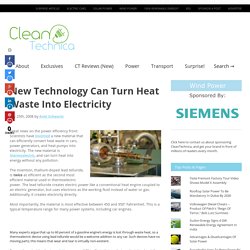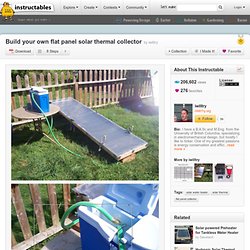

A Fifteen-Year-Old Has Invented an Incredible New Kind of Flashlight. New Technology Can Turn Heat Waste Into Electricity. July 25th, 2008 by Ariel Schwartz Great news on the power efficiency front: Scientists have invented a new material that can efficiently convert heat waste in cars, power generators, and heat pumps into electricity.

The new material is thermoelectric, and can turn heat into energy without any pollution. The invention, thallium-doped lead telluride, is twice as efficient as the second most efficient material used in thermoelectric power. The lead telluride creates electric power like a conventional heat engine coupled to an electric generator, but uses electrons as the working fluid instead of water or gas. Additionally, it creates electricity directly. Most importantly, the material is most effective between 450 and 950° Fahrenheit. Many experts argue that up to 60 percent of a gasoline engine’s energy is lost through waste heat, so a thermoelectric device using lead telluride would be a welcome addition to any car.
Posts Related to Alternative Energy Sources: About the Author. Solar cooker. The Kyoto Box, a $6 solar cooker made from cardboard, has won the Financial Times-sponsored Climate Change Challenge contest for innovative ways to decrease the human impact on the environment.

Its capacity to not only cook food but also sterilize water could help three billion people reduce their greenhouse gas emissions. The Kenya-based Norwegian creator of the cooker, Jon Bøhmer, has been awarded $75,000 to put the idea into production. Named after the United Nations’ Kyoto Protocol, the cooker is made from two cardboard boxes, one inside the other, with either paper or straw insulation placed in between; an acrylic cover on top lets in and traps sunlight. Black paint on the inner box, and silver foil on the outer one, help concentrate the heat. The trapped rays make the inside hot enough to cook casseroles, bake bread and boil water [CNN].
The box can be produced in standard cardboard factories, and Bøhmer is already working with one factory in Nairobi. Image: John Bohmer. Free Energy Nitinol Heat Machines invented in the early 1970's, where are they now? Harvesting Human Heat. What does it take to harness the energy of the human body in order to heat a building?

The idea may conjure images of people running on hamster wheels or a bicycle pedal-powered generator, but all it requires – according to the latest Swedish innovation – is the reliable hustle and bustle of people moving through a train station. The station is Stockholm Central Station, whose 250,000 daily travelers and shoppers make it the busiest train depot in Scandinavia. Engineers for real estate company Jernhusen figured out how to harness their heat energy and direct it to an office building across the street. According to an article in The 9 Billion (a website that promotes sustainability by 2050, when the world is expected to have a population of nine billion), heat exchanges in the station’s ventilation system convert only the excess body heat into hot water, which is then pumped into the heating system of the other building.
Considering the cost and energy savings, it’s a great idea. Build your own flat panel solar thermal collector. The collector is made from corrugated plastic sheet, commonly used for making signs.

It has multiple square channels running lengthwise from end to end. When I first saw this type of sheet I immediately thought, "Wow, this would make an excellent flat panel solar collector if only there was a way to pipe water through all those little channels. " Several weeks later, a method of doing so occurred to me. If a slot of the right width is cut lengthwise in some ABS pipe (so the cross section looks like a "C") then this pipe can be fit over the end of the corrugated plastic. The seams can be sealed to make everything water tight. Because the whole collector is made of plastic, it is important that the temperature doesn't get too high or it will soften and possibly spring a leak. 80 degrees C (176 degrees F) is about the limit. Your body heat could power future devices.